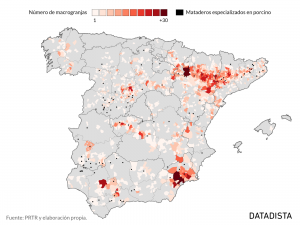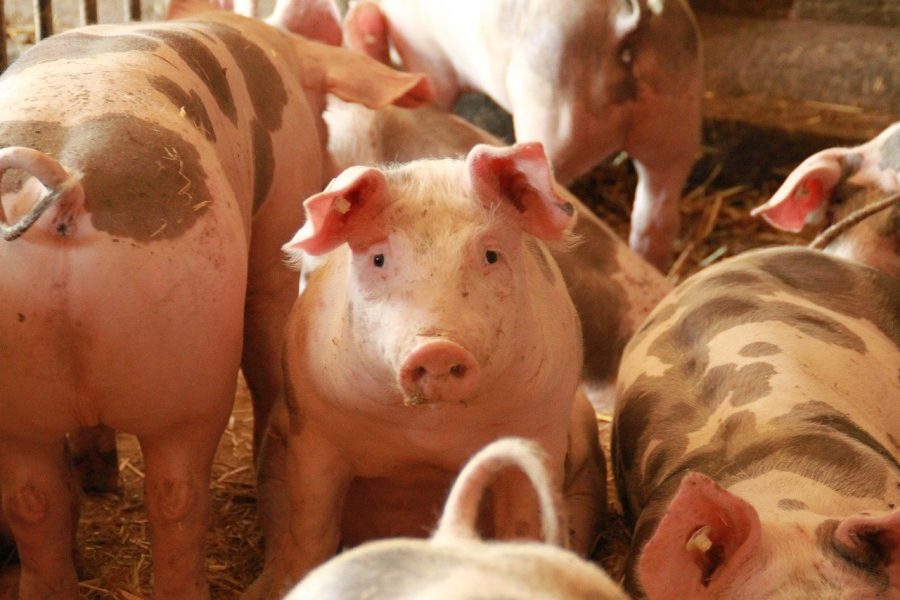TOLEDO – The Spanish region of Castilla-La Mancha may house more than 250,000 extra pigs in megafarms. To this end, the regional government is dealing with 68 files, despite a moratorium on the establishment of new intensive pig facilities.
The Junta de Castilla-La Mancha is studying 68 macro-agricultural projects. The moratorium was approved in January last year. However, these projects were not included. Furthermore, it will not affect projects already in the pipeline. The research platform lamarea.com has found through a transparency petition that 18 projects are ‘pending initiation’ and 50 projects are already ‘under consideration’. Based on this information, researchers conclude there will be more than 250,000 extra pigs in the region if the government approves the projects.

Municipalities with the most megafarms in Spain
Number of 250,000 pigs incomplete
However, according to lamarea.com, the figure is incomplete. Of the 18 files that are still in process, the number of pigs they would house is unknown for 11 files. According to the Transparency Unit of the Ministry of Sustainable Development of the region, this is because “these files have not yet been reviewed and registered.
More than 2 million pigs in megafarms acceptable?
Castilla-La Mancha currently has 1.7 million pigs. This is according to a 2021 study by the national Ministry of Agriculture. The Agriculture Minister García-Page called the moratorium a “procedural break”. The intention is to gain more consensus on the “socially sensitive” issue. The many mobilisations of residents against the megafarms are showing the sensitive nature of opening such installations with pigs.
Lamarea.com wonders if Castilla-La Mancha has enough capacity to house more than 250,000 new pigs. The Ministry of Sustainable Development says that they can only speak of ‘environmental effects’ on a case-by-case basis. Would a pig count in that region of over 2 million animals be acceptable? The answer is the same: ‘The governments give permits for pig facilities based on the environmental legislation. We are not talking about acceptable figures, but about possible environmental effects”.
Also read: Mega stables are driving away residents from Spanish rural villages
The area vulnerable to nitrate pollution
Remedios Bobillo is the president of the Association Pueblos Vivos Cuenca. He explains experts consider “almost half of Castilla-La Mancha as an area vulnerable to nitrate pollution.” “We have been asking for strategic environmental reporting of the entire sector from the government for years. So far, the authorities estimated only the individual environmental impact of each macro company. While we also need to look at the combined impact of all companies in an area,” adds Bobillo.
The region yet overcrowded with pigs
However, his organisation opposes the industrial livestock model as a whole, regardless of where the farms are located. The coordinator of the Stop Industrial Livestock campaign of Ecologistas en Acción, Daniel González, shares this view too. The region is already overcrowded with pigs according to this small farmer. “It’s not about the 250,000 pigs that come in, but what we need to do to reduce the livestock we have.
See also: The limits are in sight for Spanish macro farms
Pueblos Vivos Cuenca analysed the list of projects provided to lamarea.com. After that, they determined at least 22 of them are in areas vulnerable to nitrate pollution. In addition, they point to some particularly striking cases. One of them is applying for a farm with 2,100 sows producing piglets up to 6 kg in Cardenete (Cuenca). This town is located in the Valle del Cabriel Biosphere Reserve. Last year, the city council unanimously approved a motion urging the regional government to impose a moratorium on macro-farms.
Tap water ‘smells and tastes bad’
Another project concerns a farm of 4,000 fattening pigs in Polán. More than 70,000 pigs already live in this Toledo city of only 3,900 inhabitants. Residents here complain about the manure nuisance and that the tap water ‘smells and tastes bad.
The government approved the moratorium in mid-January and it will last until December 31, 2024. However, the organisations who fight against this type of industrial livestock farming are still not satisfied with the new standard.
Also read: Spanish minister criticizes factory farming: ‘Bad meat from abused animals’
Remedios Bobillo says there is a ‘trap’ in the moratorium. “The law says that the moratorium does not apply to projects which use the best available techniques for the recovery of waste such as the treatment of slurry”. Those projects can just start. According to Bobillo, this could mean “building biogas plants with European funds and opening new macro-farms nearby with these facilities.”


